When life throws a curveball, what’s your first move? Do you face it head-on, or do you find something—anything—to take the edge off? The strategies we lean on in tough moments are called coping mechanisms, and they're the tools we use to manage stress, painful emotions, and difficult situations.
Think of them as your personal emotional toolkit. A well-stocked kit helps you navigate life's challenges and build genuine resilience, not just mask the problem for a little while.
Defining Your Emotional Toolkit
Let's imagine your emotional well-being is a garden. Healthy coping is like actively tending to it—you’re pulling weeds, watering the plants, and enriching the soil. It takes conscious effort, but the result is a garden that's strong, vibrant, and can weather a storm.
On the flip side, unhealthy coping is like throwing a tarp over a patch of weeds. Sure, it hides the problem for a moment, but underneath that tarp, the weeds are just getting stronger and more tangled.
This distinction is everything. A lot of things can make us feel better in the short term, but a truly healthy coping mechanism is one that supports your long-term mental health, either by addressing the problem itself or by helping you process your feelings about it constructively.
Two Core Approaches to Coping
Most strategies fall into two main categories. Knowing the difference helps you pick the right tool for the job.
Problem-Focused Coping: This is all about taking direct action to change or eliminate the source of your stress. You're tackling the problem head-on. If a huge project at work is overwhelming you, breaking it down into smaller, manageable tasks is a classic problem-focused approach.
Emotion-Focused Coping: This approach is for managing your emotional reaction to a stressor, especially when the situation is totally out of your control. You can’t do anything about being stuck in a massive traffic jam, for instance. But you can use deep breathing exercises to calm your frustration and keep your cool. That's emotion-focused coping in action.
The infographic below gives a great visual of how these two core strategies work together.
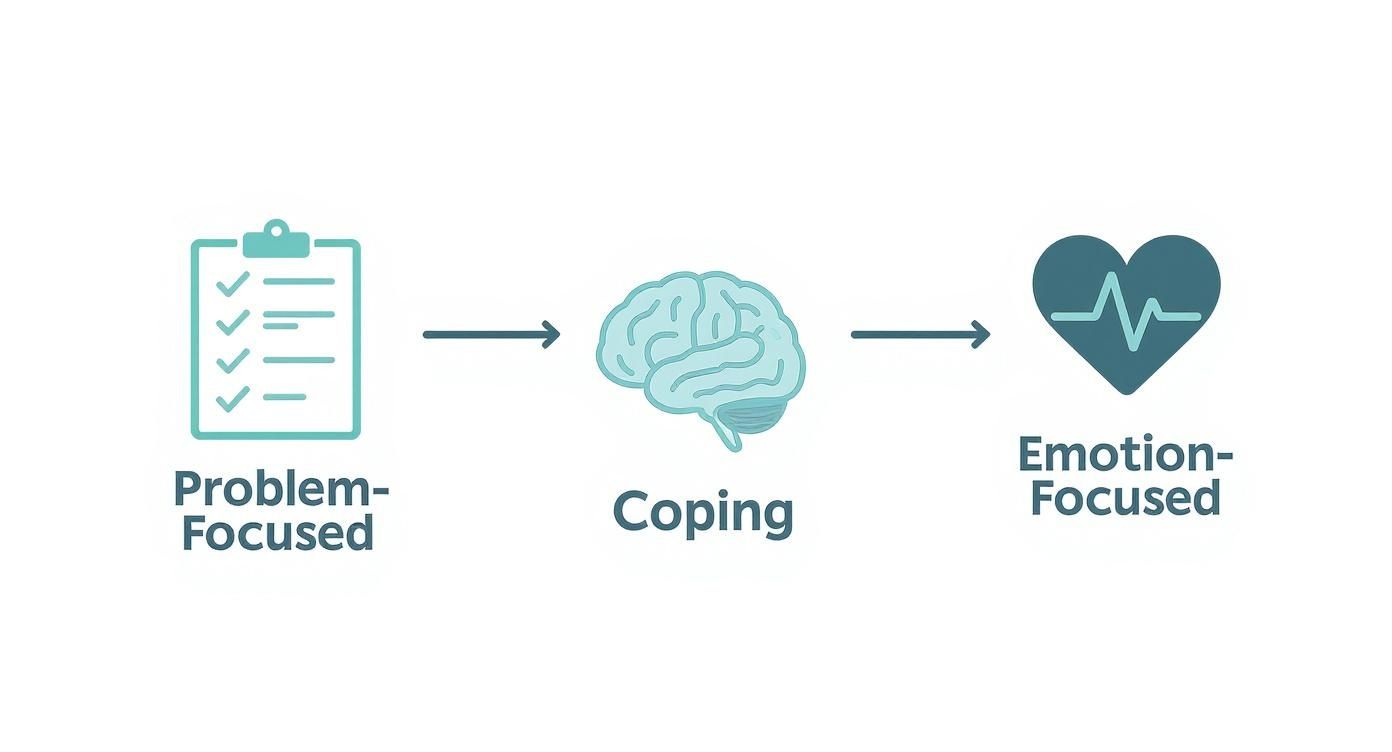
As you can see, effective emotional regulation isn't about just one or the other. It's about having both practical problem-solving skills and the ability to manage your feelings when problems can't be solved right away.
To give you a clearer picture of how this plays out in real life, let's look at some side-by-side examples. The table below contrasts healthy, constructive responses with their unhealthy, destructive counterparts in common stressful situations.
Healthy vs Unhealthy Coping At a Glance
| Situation | Healthy Coping Mechanism (Constructive) | Unhealthy Coping Mechanism (Destructive) |
|---|---|---|
| Feeling Overwhelmed at Work | Prioritize tasks, ask a colleague for help, or take a short walk to clear your head. | Procrastinate by scrolling social media, drink excessively after work to "unwind," or lash out at coworkers. |
| Conflict with a Loved One | Use "I" statements to express your feelings calmly, suggest taking a break to cool down, and actively listen to their perspective. | Yell, give the silent treatment, bring up past grievances, or use substances to numb the anger or sadness. |
| Receiving Bad News | Allow yourself to feel the emotion, talk it through with a trusted friend or therapist, and engage in a soothing activity like listening to music. | Deny the reality of the situation, isolate yourself from everyone, or engage in risky behaviors to distract from the pain. |
| Financial Stress | Create a budget, seek financial counseling, look for ways to increase income, and practice gratitude for what you have. | Avoid looking at bank statements, use retail therapy for a temporary mood boost, or turn to gambling. |
This table highlights a simple truth: healthy coping builds you up, while unhealthy coping breaks you (and often your relationships) down over time. It's about choosing the path that leads to long-term strength, not just immediate relief.
When you're dealing with specific challenges like brain fog, finding targeted coping strategies for brain fog is a perfect example of problem-focused coping. In the next sections, we'll dive deeper into a wide range of these practical, evidence-based strategies you can start using today.
The Four Pillars of Effective Coping Strategies

If you're going to build a reliable emotional toolkit, you need more than just a random collection of skills. Effective coping isn't about guesswork; it's about strategically picking the right tool for the job at hand. The best way to do that is to organize healthy coping mechanisms into four foundational pillars.
Think of these pillars as the blueprint for your wellness practice. They help you move from simply reacting to stress to responding with intention and clarity. Each one addresses a different angle of a tough situation, giving you a balanced, adaptable approach to whatever life throws your way.
Pillar 1: Problem-Focused Coping
This pillar is all about action. Problem-focused coping means taking direct steps to tackle the root cause of your stress. It’s not about changing how you feel about the situation—it’s about changing the situation itself.
Imagine you're completely overwhelmed by a massive work project. Instead of letting the anxiety paralyze you, you could create a detailed, step-by-step action plan. You’d break the project into smaller, manageable tasks, set realistic deadlines, and delegate where possible. This strategy confronts the source of the stress head-on, giving you a tangible sense of control.
Key Takeaway: Problem-focused coping works best when you actually have some control over the outcome. It empowers you to be an active participant in solving your own challenges, not a passive victim of your circumstances.
Pillar 2: Emotion-Focused Coping
Sometimes, you just can't change the situation. That's when emotion-focused coping becomes your most valuable asset. This pillar is all about managing your emotional reaction to stressors that are outside of your control.
For instance, if you're stuck in an unexpected, hour-long traffic jam, there’s no problem-focused solution. Instead, you can pull out an emotion-focused skill. Taking five minutes for a guided mindfulness meditation or practicing deep breathing can de-escalate frustration and anxiety, helping you keep your cool even when everything around you is chaotic.
Pillar 3: Social Support
This pillar rests on a fundamental human truth: we are not meant to face our struggles alone. Seeking social support means reaching out to others for comfort, advice, or just a listening ear. It’s about leveraging the strength of your connections to lighten your emotional load.
This isn't just about venting; it’s about having constructive conversations. After a hard day, you might call a trusted friend and say, "I'm struggling with something and could really use your perspective." This opens the door for genuine connection and shared problem-solving. A strong support system is one of the most powerful buffers against stress, which is a core idea in building a safe healing environment like the one described in these trauma-informed care principles.
Pillar 4: Meaning-Making
The final pillar, meaning-making, is about shifting your perspective to find purpose or a "silver lining" in difficult circumstances. It’s not about ignoring pain but about fitting it into a larger, more hopeful story. This helps you reframe challenges as opportunities for growth.
Even on the toughest days, this pillar encourages you to find something to be grateful for. Maybe a setback at work taught you a valuable lesson about resilience, or a difficult conversation led to a deeper understanding in a relationship. Practicing gratitude—by keeping a journal or just taking a moment to reflect—can profoundly change your emotional state. It’s a quiet but powerful way to transform struggle into strength.
Therapist-Approved Coping Skills You Can Use Today
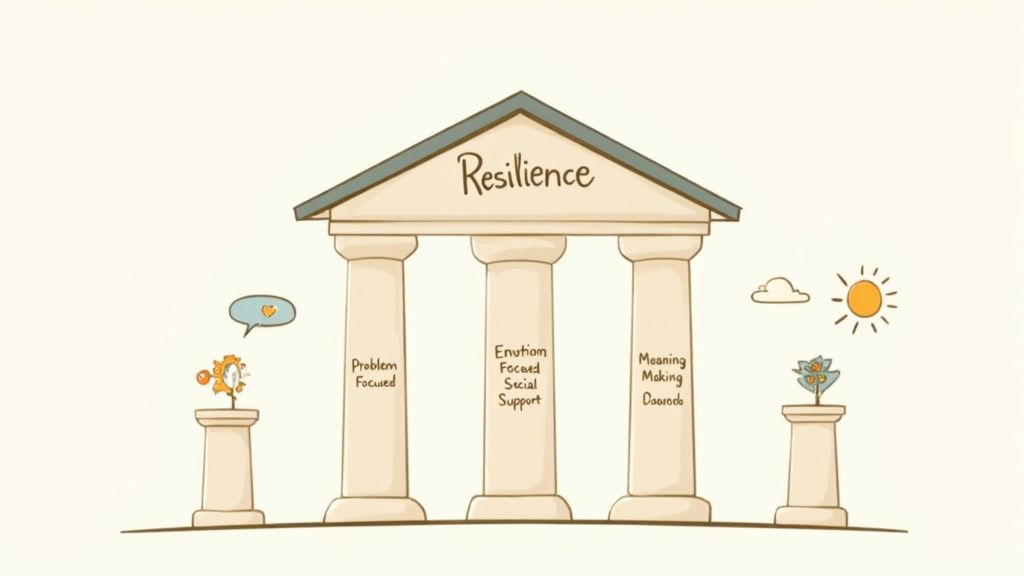
Understanding the why behind coping is the first step. Now it’s time to fill your toolkit with practical, evidence-based skills you can actually use when life gets overwhelming.
These aren't just abstract ideas; they’re powerful techniques pulled directly from some of the most respected therapeutic models out there. Think of this as getting a look inside a therapist's playbook, with actionable strategies you can start practicing the minute you finish reading.
We’re going to unpack proven tools from three heavy hitters: Cognitive Behavioral Therapy (CBT), Dialectical Behavior Therapy (DBT), and Mindfulness-Based Stress Reduction (MBSR). These are battle-tested skills that empower you to actively manage your own mental health with confidence and clarity.
Cognitive Reframing from CBT
Cognitive Behavioral Therapy is built on a simple but profound idea: our thoughts, feelings, and actions are all connected. Change one, and the others follow. So, if we can change our destructive thought patterns, we can change how we feel and what we do. The cornerstone of this practice is Cognitive Reframing.
Imagine your mind is a storyteller. After you make a mistake at work, the story it might spin is, "I'm a total failure. I mess everything up." This thought pattern, known as catastrophizing, spirals directly into feelings of shame and anxiety.
Cognitive reframing is the art of consciously challenging and rewriting that story. Instead of just accepting that negative thought as gospel, you hit pause and ask some hard questions:
- Is this thought 100% true? (Have I really never succeeded at anything?)
- What’s a more balanced way of looking at this? ("I made a mistake, which is human. I can learn from this and do better next time.")
- What would I tell a friend if they were in this exact spot? (You’d almost certainly be kinder and far more constructive.)
By questioning and adjusting your internal narrative, you strip automatic negative thoughts of their power. This single skill is fundamental for anyone looking to build better coping strategies for anxiety and depression, as it gets right to the root of the thought cycles that fuel them.
Distress Tolerance from DBT
Dialectical Behavior Therapy is all about equipping you with skills for riding out intense, overwhelming emotions without making a bad situation worse. When you’re in the middle of a crisis, you can't always solve the problem that second. That’s where Distress Tolerance skills come in.
These aren't about long-term fixes. They’re about surviving the moment. One of the most effective and immediate distress tolerance skills you can learn is the TIPP method.
- T – Temperature: Drastically change your body temperature to jolt your system out of an emotional spiral. Try splashing your face with ice-cold water or just holding an ice cube. This triggers the body's "dive response," which automatically slows your heart rate.
- I – Intense Exercise: Do a short, sharp burst of physical activity. We’re talking jumping jacks, push-ups, or running in place for just one minute. It helps burn off the frantic, nervous energy that comes with panic or rage.
- P – Paced Breathing: Deliberately slow your breathing down. Breathe in for a count of four, then breathe out for a count of six. Making the exhale longer sends a direct signal to your nervous system that it’s time to calm down.
- P – Paired Muscle Relaxation: Tense a specific muscle group as you inhale, hold it, and then release the tension completely as you exhale. Go through different muscle groups—hands, shoulders, legs—to let go of physical stress.
The TIPP method is your emergency brake for when your emotions feel like they're flooding the engine.
Body Scan Meditation from MBSR
Mindfulness-Based Stress Reduction teaches us how to be present with whatever we’re experiencing, without judging it. We often carry stress physically without even realizing it—a clenched jaw, tight shoulders, a knot in the stomach. The Body Scan Meditation is a simple practice for reconnecting with your body and letting go of all that stored tension.
The goal isn’t to force the sensations to disappear. It’s simply to notice them with curiosity and acceptance. When you bring gentle awareness to physical tension, you often give it permission to release all on its own.
To try it, just lie down comfortably and bring your attention all the way down to your feet. Notice any sensations you find there—warmth, tingling, pressure—without labeling them "good" or "bad." Then, slowly, you move your awareness up through your body: your legs, your torso, your arms, and finally, your head, paying gentle attention to each part along the way.
This practice grounds you in the present moment and helps you build a much kinder relationship with your own body. It’s a vital skill, especially when you consider that projections show that by 2025, over 1 billion people will be living with mental health conditions, with anxiety and depression leading the pack. As research from the World Health Organization highlights, adaptive strategies like mindfulness are absolutely key to building resilience against the stressors of modern life.
Applying Coping Skills for Recovery and Resilience
When you’re navigating recovery from addiction or managing a chronic mental health condition, healthy coping skills aren't just helpful suggestions—they're your lifeline. Knowing the theory is a great start, but the real magic happens when you apply those skills in the heat of a real-world challenge.
Recovery isn't a passive state you just arrive at; it's an active, skill-based journey toward stability.
Think of it this way: anyone can own a toolbox, but a skilled carpenter knows exactly which tool to grab and how to use it to build something that lasts. Let's look at some practical scenarios showing how you can use your coping tools to build a resilient life, one challenge at a time.
From Craving to Calm: Urge Surfing in Action
In addiction recovery, cravings can feel like massive waves threatening to pull you under. The instinct is to fight them head-on, but that usually just drains your energy and makes the urge feel even stronger. A much better strategy is urge surfing.
Instead of battling the craving, you learn to ride it out.
Imagine someone in recovery who suddenly feels an intense urge to use. Here’s how they could put urge surfing into practice:
- Acknowledge the Urge: First, they simply notice the craving without judgment. "Okay, a craving is here. This is a normal part of recovery."
- Observe the Sensations: Next, they get curious about the physical feelings. "My heart is racing, my palms are sweaty, and I feel a knot in my stomach."
- Ride the Wave: They visualize the craving as an ocean wave, knowing it will build, crest, and then naturally fade. They remind themselves that no urge lasts forever.
This mindfulness-based skill transforms a desperate battle into a manageable event. By observing the craving instead of reacting to it, you strip it of its power and prove to yourself that you can handle the discomfort without giving in.
Navigating Social Anxiety with a Practical Toolkit
Managing a mental health challenge like social anxiety also demands a practical, hands-on approach. Picture someone with social anxiety who gets invited to a big networking event. The thought alone triggers intense fear, but avoiding it isn't an option.
Recovery Toolkit: This is your personalized collection of go-to strategies for tough moments. It should include a mix of problem-focused skills, emotion-focused skills, and a list of supportive contacts you can call when you need backup.
Instead of letting panic take over, they can build a game plan using their recovery toolkit. Here’s what that looks like:
- Problem-Focused Prep: They prepare a few open-ended questions and talking points beforehand. This eases the pressure of making small talk from scratch.
- Emotion-Focused Grounding: If they feel overwhelmed at the event, they can step into a quiet corner and use the 5-4-3-2-1 grounding technique—naming 5 things they see, 4 they can touch, 3 they hear, and so on—to pull themselves back to the present moment.
- Boundary Setting: They give themselves permission to leave after a set amount of time, say, one hour. This makes the event feel manageable instead of infinite. To learn more about this vital skill, see our guide on setting boundaries in recovery.
This combination of preparation and in-the-moment skills empowers them to face a tough situation with confidence, turning a potential trigger into an opportunity for growth.
Building Your Personalized Recovery Toolkit
Everyone's journey is unique, and your toolkit should be, too. Building resilience is an ongoing process of figuring out what works for you and practicing it until it becomes second nature.
For those feeling drained from long-term stress, exploring strategies for recovering from burnout and reclaiming energy can be a crucial part of building that kit.
Your toolkit might include creative outlets like painting, physical releases like running, or just a list of friends you can count on. The key is to have a diverse set of healthy coping mechanisms ready, so you can always choose the right tool for the job.
Weaving Healthy Coping into Your Daily Routine
Think of healthy coping skills less like a fire extinguisher you only grab in a crisis and more like a daily workout for your mind. It’s not about reacting to stress after it hits; it’s about proactively building the mental muscle to handle whatever comes your way. This isn’t about a massive life overhaul. It's about small, consistent actions that quietly compound over time, turning intentional practices into your new normal.
The goal is to build a lifestyle where managing your well-being feels as automatic as brushing your teeth.
And the need for these skills has never been more urgent. Globally, mental health challenges are on the rise. Back in 2019, around 970 million people were living with a mental disorder. That number has now climbed past 1 billion. These aren't just statistics; they represent a massive part of the global disease burden, making it crystal clear that we all need accessible, effective strategies to stay well. You can explore more of these vital mental health statistics and their implications from South Denver Therapy.
Create Your Personal Coping Plan
One of the best first steps is to create your own personal coping plan. It’s a simple, written guide that connects your specific stressors to effective coping strategies. That way, you’re not scrambling to come up with a solution when you’re already feeling overwhelmed.
Step 1: Identify Your Unique Stressors
Start by making a list of the situations, feelings, or triggers that consistently throw you off balance. Be brutally honest and specific.
- Work-related: A looming deadline, that difficult colleague, an inbox that feels like an avalanche.
- Personal Life: Arguments with family, money worries, a quiet weekend that slips into loneliness.
- Internal Triggers: That nagging inner critic, anxiety about the future, sheer physical exhaustion.
Step 2: Map Your Strategies to Your Stressors
Next to each stressor you listed, write down one or two healthy coping skills you can deploy. This proactive matching removes the guesswork when you're in the heat of the moment.
Example Coping Plan:
- When my work inbox feels overwhelming… I will get up from my desk for five minutes and do a round of box breathing.
- When an argument with my partner starts escalating… I will say, "I need a quick break," and take a ten-minute walk to cool down.
- When I feel lonely on a Saturday afternoon… I will call or text someone from my support list instead of mindlessly scrolling social media.
Start Small and Build Momentum
The secret to making these skills stick is to start with actions so small they feel almost effortless. The goal here is consistency, not overnight perfection. You wouldn’t try to bench press 300 pounds on your first day at the gym, right? You start with light weights and build up.
Here are a few ways to gently weave coping skills into your routine:
- Schedule a "Breathing Break": Pop a five-minute reminder on your calendar between meetings just to sit and focus on your breath. That’s it.
- Commit to a Post-Dinner Walk: A simple ten-minute stroll can do wonders for clearing your head and digesting the day’s events.
- Practice One Mindful Moment: Pick one thing you do every single day—like drinking your morning coffee—and do it with your full attention. Notice the aroma, the warmth of the mug, the taste.
By weaving these tiny practices into the fabric of your day, you’re building a powerful and automatic system of self-regulation. Coping transforms from something you have to do into a fundamental part of who you are, equipping you to meet life's challenges with far more ease and confidence.
Knowing When to Seek Professional Support
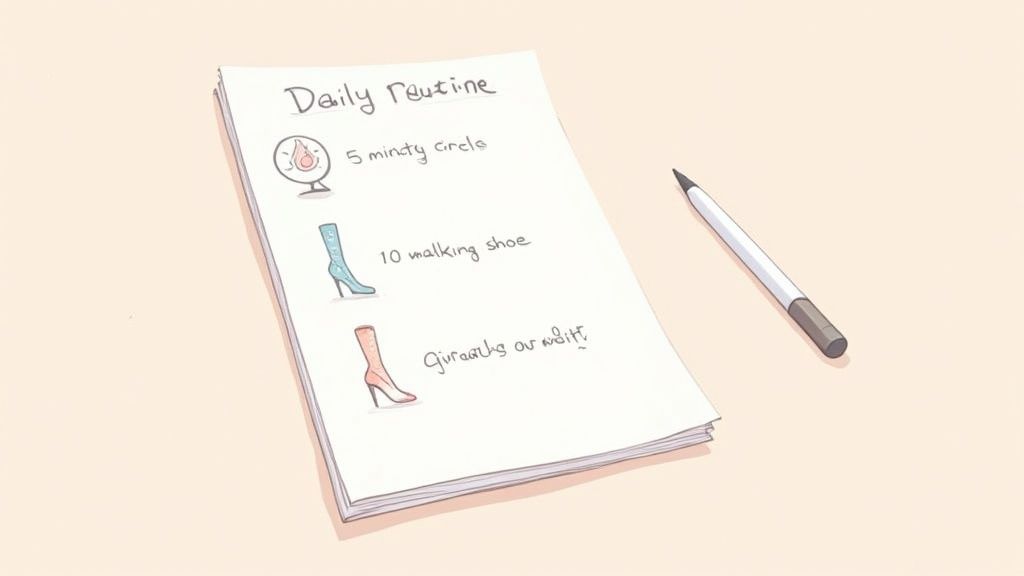
Self-help techniques—like journaling, deep breathing or a daily walk—can fix a lot of “home repairs” in your mind. But just as you’d hire an electrician for complex wiring, there are moments when a trained professional makes all the difference.
Seeing a therapist isn’t a sign you’ve failed; it’s choosing to learn advanced skills that strengthen your mental health toolbox.
Knowing exactly when to ask for help can feel unclear. Yet, certain red flags make the decision easier.
Key Signs It Is Time For Help
Pay attention if your go-to strategies leave you stuck or even set you back. Self-guided work can only carry you so far—beyond that, expert guidance can lift the load.
You might need extra support if:
- Your Coping Tools Feel Ineffective: You practice mindfulness or breathing exercises, but anxiety, sadness, or overwhelm keep returning.
- Symptoms Interfere With Daily Life: Struggling to get through work or school, keep up with chores, or maintain relationships signals a deeper issue.
- Your Main Coping Skill Is Avoidance: If you find yourself isolating, procrastinating, or leaning on substances to mute uncomfortable feelings, it’s time to pause.
- You Experience Thoughts of Self-Harm: Any urge to harm yourself or others calls for immediate professional help—no exceptions.
Important Takeaway: Therapy is not a last resort for when things are broken beyond repair. It is a proactive step toward building a stronger, more resilient foundation for your mental well-being.
Finding The Right Professional For You
Choosing a therapist shouldn’t feel like wandering in the dark. Different specialists bring different tools—knowing their strengths makes the search less intimidating.
A therapist, for instance, can guide you through techniques such as motivational interviewing therapy to help you uncover your own motivations and practice change in real time.
Don’t let cost stop you. Many community health centers, university training clinics, and online platforms offer sliding-scale fees or low-cost options. Your primary care doctor is another great source for trusted referrals.
Taking that first step takes courage. Reaching out is your chance to build a healthier, more balanced life—one conversation at a time.
Your Questions About Coping Mechanisms, Answered
As you start exploring healthier ways to handle stress, it’s only natural for practical questions to pop up. Moving from theory to real-world application can feel a bit uncertain, so let's clear up a few of the most common sticking points people run into.
Think of this as a quick-reference guide. The goal is to give you the clarity and confidence you need to put these tools to work in your own life.
How Long Does It Take to Develop a Healthy Coping Skill?
Building a new coping skill is a lot like building muscle at the gym—it takes consistent practice over time. There’s no magic number, but most people start to feel a new strategy become more automatic and comfortable after a few solid weeks of regular use.
The trick is to practice these skills when you’re calm, not just in the middle of a crisis. That proactive approach builds the "muscle memory" you need, making the skill second nature when you really need it. The mantra here is progress, not perfection.
Can a Coping Mechanism Be Both Healthy and Unhealthy?
Absolutely. The line between helpful and harmful often comes down to context, frequency, and outcome. An activity isn't inherently "good" or "bad"—it’s how you use it that matters.
For example, unwinding with an episode of your favorite show after a long day is a perfectly healthy way to decompress. But if you find yourself binge-watching for hours specifically to avoid a problem you need to face, it’s tipped over into unhealthy escapism.
The most important question you can ask is this: "Is this helping me process and solve my problem, or is it just helping me delay it?" If it consistently creates more stress down the road, it has probably shifted from a helpful tool to an unhealthy crutch.
What if All My Coping Mechanisms Are Unhealthy?
First off, just recognizing that pattern is a huge, courageous first step. That kind of self-awareness is the bedrock of real change, so give yourself credit for that. The key now is not to get overwhelmed or try to overhaul everything at once.
Start by picking just one small, healthy replacement. Instead of doomscrolling on your phone when anxiety hits, maybe you try a five-minute walk around the block. Instead of pouring a drink after a stressful meeting, you could try journaling for a few minutes. The idea is to slowly introduce new, positive habits that can eventually crowd out the old ones.
If that feels like too much to handle on your own, it’s the perfect time to reach out to a therapist. A professional can offer the guidance, structure, and accountability that make building a healthier toolkit feel manageable.
At Altura Recovery, we know that learning healthy coping mechanisms is fundamental to building a lasting recovery. Our evidence-based outpatient programs in Houston are designed to give you the tools and support needed to manage life’s challenges with confidence. Learn more about our approach at https://www.alturarecovery.com.

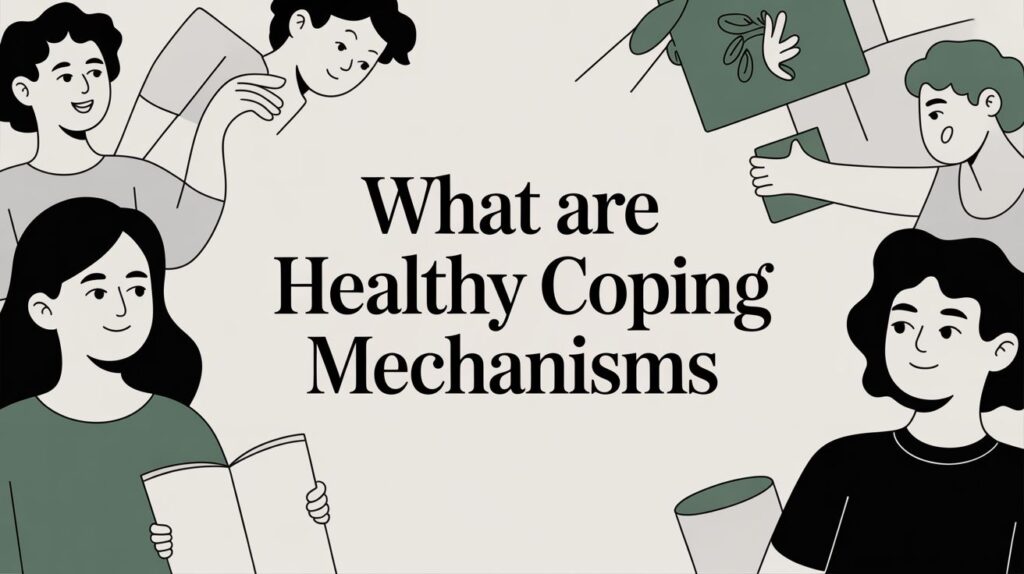
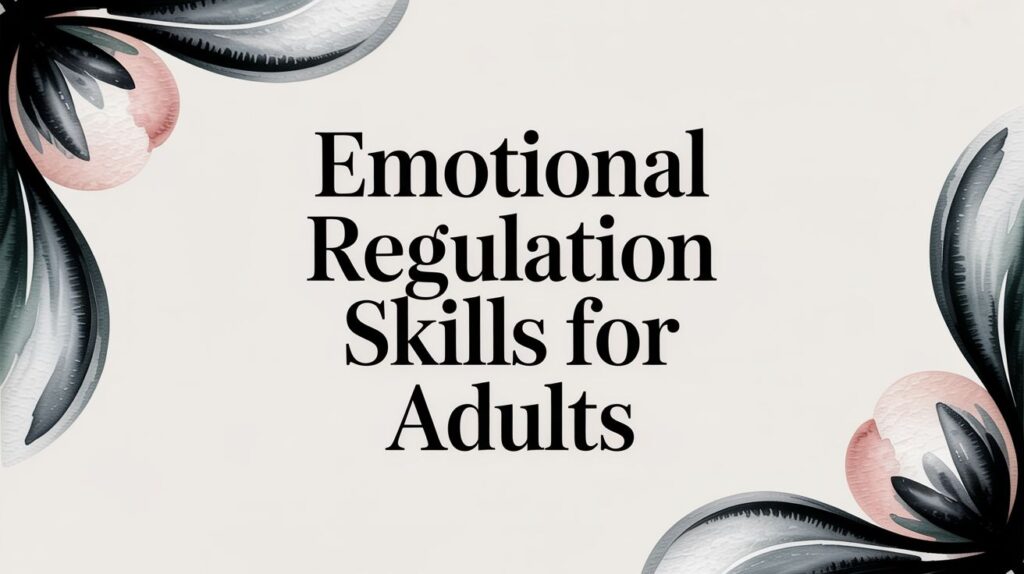
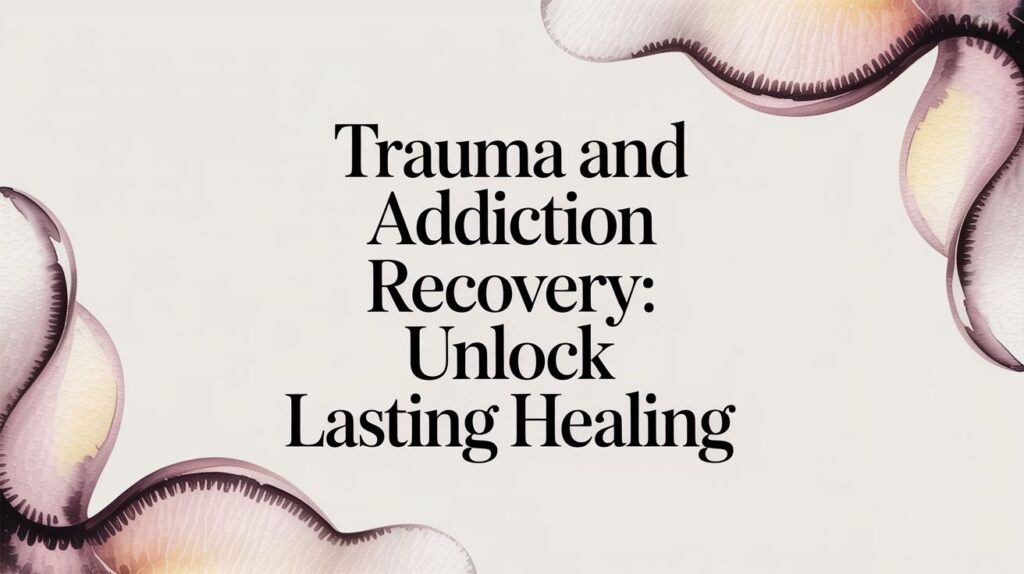

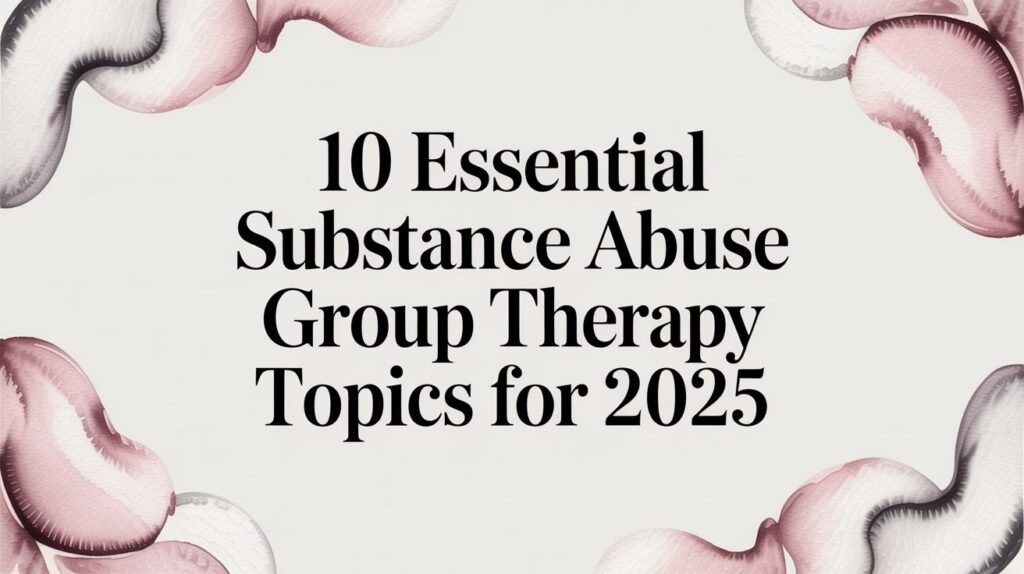
![Top 12 Dual Diagnosis Treatment Centers Texas [2025 Guide]](https://alturarecovery.com/wp-content/uploads/2025/11/thumbnail-21-1024x574.jpg)

